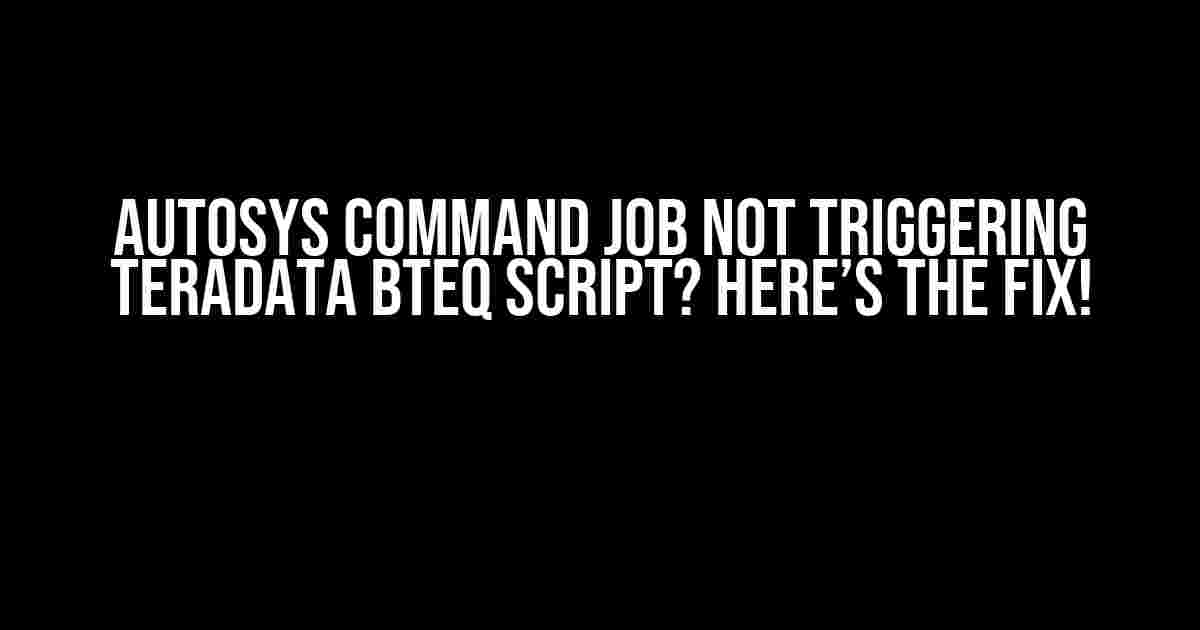Are you stuck in a situation where your Autosys command job refuses to trigger a Teradata BTEQ script? Don’t worry, you’re not alone! In this article, we’ll dive into the possible reasons and provide step-by-step solutions to get your command job up and running smoothly. Buckle up, and let’s get started!
Understanding the Basics: Autosys Command Job and Teradata BTEQ Script
Before we dive into the troubleshooting process, let’s quickly review the basics. Autosys is a job scheduling tool that automates and manages batch jobs, while Teradata BTEQ (Basic Teradata Query) is a script used to execute SQL queries on a Teradata database.
An Autosys command job is used to execute a BTEQ script, which in turn runs a series of SQL queries on the Teradata database. This integration is crucial for automating complex database operations. However, when the command job fails to trigger the BTEQ script, it can lead to critical delays and errors in your workflow.
Troubleshooting: Why is the Autosys Command Job Not Triggering the Teradata BTEQ Script?
Let’s explore the common reasons behind this issue and their solutions:
Reason 1: Incorrect File Path or Permissions
Ensure that the BTEQ script file is located in the correct directory and has the necessary permissions. Check if the Autosys job is pointing to the correct file path.
Example: File path: /usr/local/autosys/jobs/bteq_scripts/my_script.bteq
Verify that the Autosys job owner has execute permissions on the script file:
Example: chmod 755 /usr/local/autosys/jobs/bteq_scripts/my_script.bteq
Reason 2: Autosys Job Configuration Issues
Review the Autosys job configuration to ensure that it is correctly set up to execute the BTEQ script:
| Parameter | Value |
|---|---|
| Job Type | Command |
| Command | bteq script_name |
| Working Directory | /usr/local/autosys/jobs/bteq_scripts |
Verify that the job is correctly scheduled and has the necessary dependencies:
Example: job: my_job job_type: command command: bteq my_script.bteq working_directory: /usr/local/autosys/jobs/bteq_scripts
Reason 3: Teradata BTEQ Script Errors
Review the BTEQ script for any syntax errors or invalid commands:
Example: .LOGON 127.0.0.1/username,password RUN FILE = my_script.sql .LOGOFF
Ensure that the script is correctly formatted and has the necessary .LOGON and .LOGOFF statements:
Example: .LOGON 127.0.0.1/username,password RUN FILE = my_script.sql .LOGOFF EXIT 0
Reason 4: Network Connectivity Issues
Verify that the Autosys job can connect to the Teradata database:
Example: telnet 127.0.0.1 1025
If the connection fails, check the network configuration and ensure that the necessary firewall rules are in place.
Reason 5: Autosys Agent Configuration Issues
Review the Autosys agent configuration to ensure that it is correctly set up to execute the command job:
Example: agent_name: my_agent agent_type: command
Verify that the agent is correctly configured to execute the BTEQ script:
Example: agent_dependency: my_job
Solution: Step-by-Step Guide to Fix the Autosys Command Job
Follow these steps to fix the Autosys command job and trigger the Teradata BTEQ script:
-
Stop the Autosys job using the following command:
sendevent -E STOP -j my_job
-
Verify the file path and permissions of the BTEQ script:
ls -l /usr/local/autosys/jobs/bteq_scripts/my_script.bteq
-
Update the Autosys job configuration to point to the correct file path:
jde modify_job -j my_job -c "command=bteq /usr/local/autosys/jobs/bteq_scripts/my_script.bteq"
-
Verify the Teradata BTEQ script for any syntax errors:
bteq -f my_script.bteq
-
Update the BTEQ script to include the necessary .LOGON and .LOGOFF statements:
.LOGON 127.0.0.1/username,password
RUN FILE = my_script.sql
.LOGOFF
EXIT 0
-
Verify the network connectivity to the Teradata database:
telnet 127.0.0.1 1025
-
Start the Autosys job using the following command:
sendevent -E START -j my_job
Conclusion
In this article, we’ve covered the common reasons behind the Autosys command job not triggering the Teradata BTEQ script. By following the step-by-step guide and troubleshooting tips, you should be able to resolve the issue and get your command job up and running smoothly. Remember to double-check the file path, permissions, and script syntax to avoid any errors. Happy troubleshooting!
Additional Resources
For further assistance, refer to the following resources:
We hope this article has been helpful in resolving the Autosys command job issue. If you have any further questions or concerns, feel free to ask in the comments below!
Frequently Asked Question
Hey there, Autosys and Teradata enthusiasts! Are you stuck with an Autosys command job that refuses to trigger your Teradata BTEQ script? Don’t worry, we’ve got you covered! Here are some frequently asked questions and answers to help you troubleshoot and resolve the issue.
Q1: Is the Autosys job configuration correct?
A1: Double-check the job configuration in Autosys to ensure that the command job is correctly defined, and the Teradata BTEQ script is specified as the command. Verify that the script path, username, and password are correct.
Q2: Are the Teradata BTEQ script permissions correct?
A2: Ensure that the Teradata BTEQ script has the correct permissions and ownership. The Autosys job should have execute permissions on the script, and the script should be owned by the correct user.
Q3: Is the Autosys agent configured correctly?
A3: Verify that the Autosys agent is correctly configured to run the command job. Check the agent status, ensure it’s running, and review the agent logs for any errors.
Q4: Are there any firewall or network issues?
A4: Check for any firewall or network issues that might be blocking the Autosys job from triggering the Teradata BTEQ script. Ensure that the required ports are open, and the network connection is stable.
Q5: Have you checked the Autosys and Teradata logs?
A5: Review the Autosys and Teradata logs to identify any error messages or exceptions that might indicate the cause of the issue. This can help you pinpoint the problem and take corrective action.
